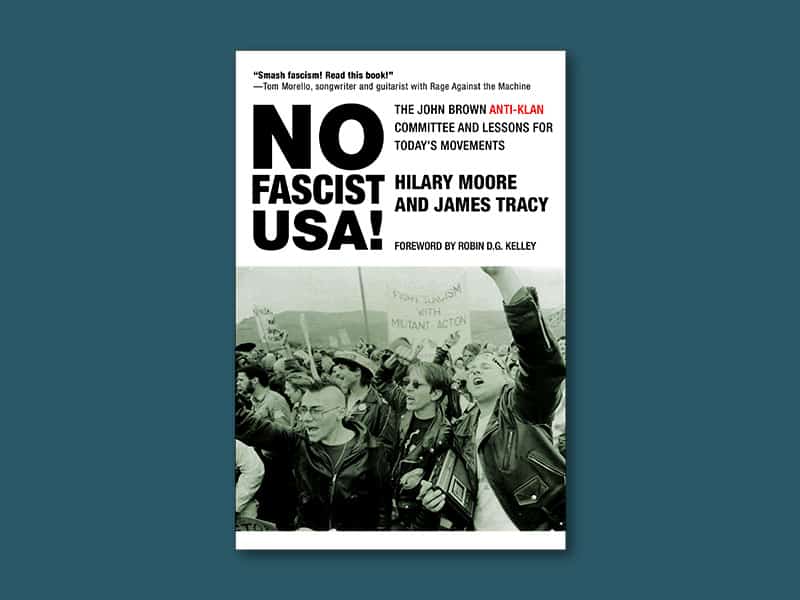No Fascist USA!: The John Brown Anti-Klan Committee and Lessons for Today’s Movements (City Lights) is an important addition to histories of 20th-century anti-racist movements in the United States. Authors Hilary Moore and James Tracy spent time with veterans of the organization of the book’s title and have come up with an overview that is both interesting and useful.
Named after the abolitionist warrior who led guerrilla attacks against pro-slavery settlers in Kansas in the 1850s and later conducted the famous 1859 raid on the Harper’s Ferry Federal Arsenal in Virginia, the John Brown Anti-Klan Committee was founded in response to an incarcerated African-American man’s appeal for help in combating Ku Klux Klan organizing within the U.S. prison system. The group organized white activists to work in solidarity with the Black Liberation Movement to combat Klan organizing both within and outside U.S. penitentiaries, beginning in the late 1970s and continuing into the Reagan era. Moore and Tracy meticulously document the organization’s trajectory through those years and its work in coordination with, and sometimes at a distance from, other anti-racist groups.
The Committee’s campaigning frequently involved directly challenging public activities of Klan and Nazi groups at a time when many liberals argued that the best strategy for dealing with such far-right groupings was to ignore them, thereby giving them no free publicity. The Committee had a different approach: to use any means necessary to deny Klan members the public spotlight. Klan members were calling for genocide against entire populations, thus their free speech rights were not something that Committee members had any interest in respecting.
John Brown Anti-Klan Committee activists didn’t shy away from physical confrontations at Klan events, leading to some situations which they were lucky to have made it through. One committee member told Moore and Tracy about marching in support of Klan-targeted Vietnamese fishermen in Texas, where her group of around 10 activists were menaced by five times as many Klan members. She recalled, “They marched around us and they knew our names. I was scared shitless, but we kept marching, because you cannot let fear stop you.”
The 1979 Greensboro, North Carolina, fatal shootings of five left-wing activists by heavily armed members of an organization called the United Racist Front, which included Klan members, showed how dangerous standing up to armed white supremacists could be. It was also one of many cases where law-enforcement officers did nothing to stop attacks on left-wing activists. The FBI and the Bureau of Alcohol, Tobacco, and Firearms knew of Klan and Nazi plans to attack anti-racists at Greensboro. The police even had an informant within the Klan who brought Klan and Nazi members together in the United Racist Front. Moore and Tracy write, “A Federal officer with [the ATF], with active knowledge and consent of his superior officers, overtly encouraged the Klan to bring bombs and guns to the rally, while pressing leftist organizers to leave any weapons at home.” The authors also point to law enforcement conducting midnight raids on the homes of anti-Klan militants and getting Klansmen to identify anti-racist militants at Klan rallies.
One could argue that Klan activities were also abetted, albeit unintentionally, by the First Amendment absolutism of the American Civil Liberties Union. The ACLU has repeatedly defended the Klan’s right to stage public events, including the notorious 2017 Charlottesville march—condoned by Donald Trump—that ended in paralegal/bartender Heather Heyer being killed by a white supremacist. Moore and Tracy quote a left-wing organizer based in Kentucky in the 1980s who recalls, “We started a campaign to demand the Klan not be allowed on the police force, but then the American Civil Liberties Union came in and defended them. It nearly stopped that work.”
One of the John Brown Anti-Klan Committee’s more successful organizing strategies was counter-recruiting, as in ’80s punk scenes where anti-racist musicians and organizers drew in new participants and then distributed information about the toxic realities of white supremacy. In doing that, they built communities of resistance that helped provide support to young people who might otherwise have fallen prey to far-right organizing. Anti-Klan Committee members also engaged in community outreach group activities, such as painting over racist graffiti.
While giving credit to the John Brown Committee for their commitment and accomplishments, No Fascist USA!also raises questions about mistakes the group made, including being excessively self-righteous and not effectively stressing the importance of fighting anti-Semitism. Moore and Tracy also cite a veteran Committee member who felt that the group’s sole focus on fighting racism overlooked class issues, hence tending to shortchange economic injustice, in their analysis.
Moore and Tracy argue that that “changes in the alt-right’s strategies point to the idea that communities must respond to actions of the far right in ways that constantly experiment and evolve with the times.” When under attack, self-defense is an obvious choice than can save lives. The authors cite activist, professor, and theologian Cornel West’s experience in Charlottesville. West told a journalist that while attempting to maintain a peaceful presence amid that hate march, “Those twenty of us who were standing, many of them clergy, we would have been crushed like cockroaches” if anti-fascists and anarchists had not come to their rescue. In other cases, mobilizing thousands of people, as was done in Boston in response to a 2017 alt-hate rally, can effectively stop far-right marchers in their tracks.
Moore and Tracy conclude that “The challenge is to move toward ever more diversity, depth, and nuance, while winning hearts, minds, and communities with the common dream that better world is possible.” Given the rising tide of proto-fascist politics in the United States, let’s hope that many more people take that challenge. This book will remain a worthwhile tool in the struggle to reach that better world.

